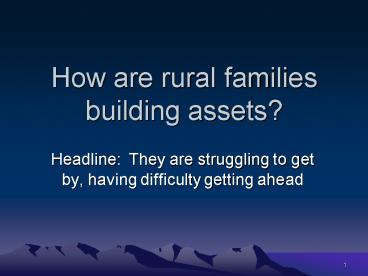How are rural families building assets - PowerPoint PPT Presentation
1 / 20
Title:
How are rural families building assets
Description:
... business, car, reduce debt, savings, retirement. Transactional financial ... car financing, debt consolidation, credit repair. Long term savings/investments ... – PowerPoint PPT presentation
Number of Views:111
Avg rating:3.0/5.0
Title: How are rural families building assets
1
How are rural families building assets?
- Headline They are struggling to get by, having
difficulty getting ahead
2
Big caveat
- When youve seen one rural community,
- youve seen one rural community
- Amenity rich areas
- Declining resource-dependent areas
- Chronically poor areas
3
Why Do Assets Matter?
- Financial shock absorber
- Getting by ?getting ahead
- Riding the tide ? raising the tide
Earn It Keep It Grow It
4
One-third of rural families have low income,
especially those with children
- More than 2/3 of single parent families
- 1/2 of families with young children
- Rural child poverty increased in 41 states
between 2000 2005
5
Place and poverty
Poverty by rural urban continuum code
Rural
Source USDA Economic Research Service
6
Race, Place and Poverty
7
Earning ItAvailable Jobs Pay Low Wages
- ¼ rural jobs would not lift a family of 4 out of
poverty if full year/full time - 42 rural jobs are low-skill and vulnerable to
dislocation - 84 consider lack of job opportunities a serious
problem - 73 would advise teen to move away for better
opportunity
Among 6500 randomly selected rural residents
surveyed by the Carsey Institute
8
Helping Families Earn It
- Address low educational attainment (Lumina)
- Build career-ladders in high-demand sectors (West
Central Initiative, Southern Good Faith Fund) - Strengthen workforce intermediaries new
National Fund for Workforce Solutions seeking
rural sites/funders (Ford, Casey, Hitachi, COF) - Use PRIs to help increase/improve jobs (Heron,
NWAF, Ford, Casey)
9
Keeping ItIncome vs. Expenses
10
High cost of being rural/poor
- Low income rural residents pay 10 - 25 more for
food - Financial services The hole in the bottom of
the bucket - High-cost, exploitive services fill the void left
by absence of mainstream financial services - Higher mortgage rates and predatory lending
practices Payday lending Check cashing Car
title loans rent-to-own refund-anticipation-loan
s
11
Closing the Gap
- 25 hold multiple jobs
- 50 do odd jobs and self-provisioning (including
microenterprise) - Going without necessities, doubling up
- ½ of bankruptcies are due to illness or medical
bills - Public benefits
- 10 rely on Food Stamps (vs. 7 urban)
- 32 of rural children rely on SCHIP or Medicaid
(vs. 26 urban)
From Carsey Institute survey
12
EITC Really Big Gap Closer
- Rewards work, boosts income
- Claimed by 18 rural families as many as 25 or
more of eligible workers dont claim. - Average rural refund /- 1700
- Families and communities benefit Generates as
much economic activity in Iowa as the hospitality
industry - Lots of philanthropic activity outreach, tax
prep policy - EITC Funders Network will convene interested
rural funders in December (WKKF and
AECF-sponsored). - Native Financial Education Coalition (Oweesta,
NEFE) - SFAI Nonpartisan state policy work, 29 states
(Casey, Mott, Ford, OSI, PWF, Knight)
13
Growing It
- The Pathway to Building Assets
14
Multiple goals Home, business, car, reduce
debt, savings, retirement
Assessment, Coaching Financial Education
(continuous appropriate to each stage)
Policy and market forces
Asset preservation Insurance, foreclosure
prevention
Long term savings/investments IDAs, homebuyer
assistance, mortgages, biz loans, 529 accounts
Short-term/emergency savings credit Savings
accounts, access to emergency loans, car
financing, debt consolidation, credit repair
Transactional financial services Checking
accounts, online bill pay, prepaid debit cards
Referral from multiple sources
15
Savings would provide a cushion, but
- ¼ US households does not own enough to support
itself at the poverty line for three months - ¼ female-headed households and 1/3
minority-headed households has zero or negative
net worth
16
Matched Savings (IDAs)
- Good but not as rural-friendly as possible
- Federal program limits permitted uses to home,
business, education. - State and local programs offer more flexibility,
especially car purchase, equipment purchase. - Philanthropy, public sector, private sector
collaboration (national, regional, corporate,
community foundations, private donors, United
Way, financial institutions)
17
Homeownership
- Pathway to upward mobility is more complicated
for rural families - 82 own their homes, but
- Homes are worth only ½ as much as urban homes
- Home equity is 40 less than urban homeowners
- Self-help housing is an important exception
18
- Special issues in manufactured housing
- 12 of rural homes fastest growing affordable
housing - Vulnerable to predatory financing
- Coops appreciate in value
- Financing and policy initiatives underway (Ford
with CFED, Meridith Institute)
19
Business Ownership
- Small business can be a pathway to upward
mobility. - 17 of household wealth is business equity
(second only to home equity) - Philanthropy and public sector help grow
entrepreneurs - Supportive infrastructure/business climate (many
community foundations, McKnight Foundations
MIFs,) - Access to capital (PRIs)
- Research and best practices (WKKF, Heron,
National Rural Funders Collaborative)
20
For more information on rural family economic
success, visitwww.aecf.org































